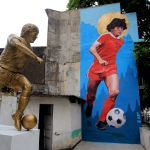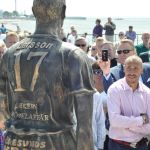
The 10 best football statues
In South America, in London, or facing the North Sea
November 25th, 2020
For a footballer, becoming an important figure for a club means going beyond being a simple sportman. To receive a statue of his own, a footballer doesn't have to be strong and that's it. He must have been able first of all to accomplish something epic, fundamental in the history of society, and then, but not because it matters less, also to be an icon off the field. If not, companies of other industries - and football clubs are totally a companies - would also have to build statues of their best employees, of those who make their mark - and indeed, many do: Steve Jobs has one inside the Apple center in Cupertino (California).
According to Bleacher Report authoritative ranking, Pelé is the seventh most appreciated sportsman in history and has a statue of his own in front of the Brazilian football museum: not in front of a stadium, icon of a single club, but in front of a museum, icon of an entire country. This is because Pelé - and many others like him - have spent so much not only on football, but also on society, for others, that it is eternalized with a monument. Just as the majestic representations of the great characters of history are important - Admiral Nelson in London, Giuseppe Garibaldi in Rome, Abraham Lincoln in Washington - sport, even with a minor historical impact, has its eternal protagonists and celebrated by a statue. nss sports has chosen the top ten.
Thierry Henry
The modern striker is calculated today based on the rate of completeness: speed, physical strength, aim, individual technique, tactically ductile. All that until 2014 was Thierry Henry. The French striker defined a way of playing football so well that he designed a style of play necessary for colleagues of the future. All this he did with Arsenal and France, but especially with the Gunners, of whom he became the all-time top scorer with 228 goals and won the Premier League in 2004. Henry was so crucial to Arsenal and his fans that, on the club's 125th anniversary, a statue was built in front of him at the Emirates Stadium. Along with his, in front of the stadium, there are also those of Tony Adams and Herbert Chapman.
Diego Armando Maradona

Juan Roman Riquelme
Sir Bobby Moore
The English live like few the concept of "football as religion". That is why Sir Bobby Moore, captain of the national team who won the only World Cup currently on the board for the English, cannot but have a statue of his own. On the other hand, in England there is the cult of statues and, as with stadiums, you could almost organize a tour. The Bobby Moore Statue is in bronze in front of Wembley Stadium, the second largest stadium in Europe and for the former West Ham player it is the second in London: it also has one in the former Boylen Ground plant, where they have now built apartments. The stadium is imponent and very scenical beacuse is very tall (6.1 metres) and made by the Royal Sculptor Philip Jackson.
Tofik Bakhramov
He's actually a mr nobody, but not for the Azeris and the British. Tofik Bakhramov was in fact the linesman of the 1966 World Cup final - the one won by England - in which one of the most great episodes in the history of the competition happened. In overtime of the final there was one of the most famous episodes of phantom goals (a phrase elaborated by that case) and the referee, having not seen, interviewed Bakhramov to make a decision, and the Azerbaijani - who, it must be said, was a match director - claimed that the ball had entered. An episode with infinite replicas and consequences. Bakhramov eventually became a national hero and was also named after the stadium where his 6-meter-high statue is placed.
The United Trinity
Andres Iniesta
The albacete statue of Andres Iniesta has a different history than the others. In addition to wanting to accentuate his vehement traits, the Hero of South Africa 2010 was in fact portrayed (in clay) initially naked, in the pose with which he beat Stekelemburg in the final of the South African World Cup, complete with is nature exposed. So it was presented last June, but on Twitter, Iniesta himself intervened on the matter to underline - jokingly - the iconography of the sculptor's work. The statue is fine, but not without shorts. So the sculpture has been rearranged with the addition of a pair of game shorts, which has had the approval of Don Andrès and will be publicly inaugurated on a date to be allocated - due to the coronavirus.
Henrik Larsson
The statue of Larsson is perhaps one of the most beautiful in relation to the landscape. It overlooks the sea, along the Strandvägen in Helsingborg, Sweden, his hometown. The player is aimed, intent on kicking a ball, towards the North Sea. Larsson is regarded in Sweden as ibrahimovic, having been a champion around Europe before Zlatan and having done great things with the Stockholm national team. Only that Ibra's sculpture, inaugurated in 2019, has been smeared and devastated, Larsson's is still beautifully standing.
Carlos Valderrama
Materazzi-Zidane
Known ad "Headbutt", it was unveiled in Italy, in Pietrasanta (Tuscany), and then transferred to Lake Geneva, but theoretically, it is at home in front of the Centre Pompidou in Paris. The statue depicting the most famous warhead in history is five meters high and made by the Algerian artist Abdel Abdessemed. The work is very disturbing given the majestic size and dark hue of the material with which it was painted. In addition, it has caused a great much controversy because - of course - it represents a clear unsportsmanlike gesture and therefore a public exhibition is not suitable. Yet, on tv or on display, it is a gesture seen by everyone.








































.png)


.jpg)














.jpg)








.jpg)






















































































